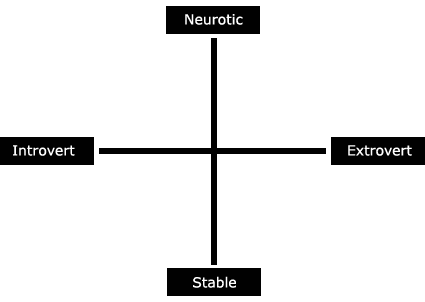Personality theories
Trait theory
It is suggested by Trait theorists such as Eysenck and Cattell that an individual has underlying personality characteristics which are consistent over a variety of situations and are therefore more likely to respond in a certain way. They believe that individuals are born with their personality characteristics.
Example:
A snooker player, who is very calm and controlled during a game, would also show they are calm and controlled when they are stuck in a traffic jam for an hour.
Eysenck and the Trait theory
Eysenck suggests that personality lies on two dimensions which lie along continuums:
The two continuums are represented as a cross where personalities can be plotted, as like on a graph. This identifies where athletes lie along the extrovert/neurotic continuum.
Eysenck's Personality Inventory
As you can see in the example, Paula Radcliffe (PR) has been identified as introvert/stable. Athletes may not easily fall in to one category and may show characteristics from each, but maybe slightly more one than the other, e.g. more introvert than extrovert and stable than neurotic. Although Paula Radcliffe maybe classed as introvert as she appears quite shy, she also demonstrates confidence when running which is classed as an extrovert trait. Similarly she often appears very level headed (stable) but she has been known to breakdown when her race is not going to plan (neurotic). Therefore she would not be placed at the extremes of the continuums.
In order to establish where personalities lie along this scale Eysenck created a questionnaire EPI (Eysenck's Personality Inventory). The inventory is a set of fifty seven questions which require a 'yes' or 'no' answer. Once completed a scoring system is used which provides a score for the extroversion scale and one for the neuroticism scale. The scale ranges from zero to twenty four.
0 = extremely introvert
24 = extremely extrovert
0 = extremely stable
24 = extremely neurotic
Like a graph identify the horizontal score (extroversion) against the vertical (neuroticism) to identify where personality lies.

